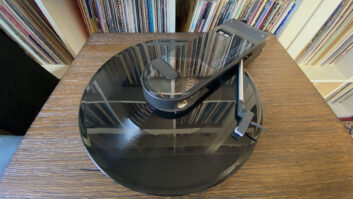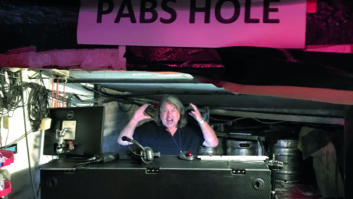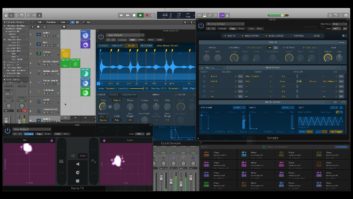It’s AES time. Thousands of us will flock to the Javits Center to drink overpriced lukewarm coffee, eat three-day-old sandwiches, lose our voices from shouting over the din and try to figure out which way to jump so as to keep ahead of the competition. And if you wonder why all of the engineers in the booths look like they haven’t slept for two weeks, it’s because they haven’t. They’ve been working around the clock trying to get their prototypes up and running for the show, or at least working well enough so no one can tell that production is actually still a year away.
But for those of us in the know — and that includes me, as I’ve been going to these things for more than 25 years (yes, I was there when the New York show was held at the Waldorf-Astoria) — the real action isn’t on the floor, or even in the private demo rooms or high-priced hotel suites. It’s in the corridors, the cheap motels and the alleyways where you will find the truly revolutionary products, from manufacturers too hip and too cheap to have an official presence at the show. And that’s what this column is about: new products that you won’t see at this month’s AES, because they’re simply too revolutionary for the general public. Like the products on the show floor these days, they break down almost entirely into two categories: control surfaces and software plug-ins.
It’s too bad that Mackie wasn’t audacious enough to trademark the words “user interface” and its attendant acronym, because we’re about to see dozens of products that will piggyback on the popularity of its HUI and Baby HUI control surfaces. Most of these will be coming from an Indonesian company well-known for its poor-quality knockoffs of other companies’ gear, and its first products, which will follow the tradition of being named after old comic-book characters, will be the “Donald’s Nephews” line, comprising “LUI” and “DUI” (pending dismissal of the expected lawsuit by Disney).
LUI® is the Lazy Users Interface. It has but one physical control: a 2-inch-diameter, trackball-like thingie that can be placed on a flat surface, held in the lap, worn on the wrist or put in your pocket. It is accompanied by a 15-inch LCD screen equipped with an eyeball tracking system that determines which parameter you are looking at and assigns the controller accordingly. (If you want to operate more than one control at a time, sticking out your tongue acts like a Shift key.) A built-in speakerphone allows hands-free communication with producers, record company executives and tech support, and a voice-operated automatic dialer connects to local sushi and pizza suppliers (small delivery charge).
DUI® stands for, depending on your predilection, either Drunk or Drugged Users Interface. It’s actually a deluxe version of the LUI and comes with cup and can holders, a self-extinguishing ashtray, and an optional mirrored surface and nasal cauterizer. The eyeball tracking system is supplemented with a brainwave interpreter, so the user doesn’t even have to be conscious to have full use of the system. The speakerphone auto-dialer has an additional feature: It calls a cab at the end of each session. Another option is a miniature blood-analysis lab designed by a well-regarded government subcontractor; its results are admissible in most traffic courts.
Should these devices prove successful, reliable reports say that there are three more models already in this company’s development pipeline: SUI™ is a special workstation controller that will be sold exclusively to record companies. It will operate in conjunction with the Watermarker plug-in (described below) to prepare legal cases against artists and consumers suspected of copyright infringement via sampling, downloading, recording streams or just humming something that they heard on the radio. It promises to be very expensive (most likely charging by the hour) and very mean.
SKRUI™ — Simulated Kinesthetic Recursive User Interface — is a highly intelligent device that uses the latest force-feedback technology from advanced game controllers. It is so intelligent, in fact, that it knows what it’s doing far better than you do, and if you try to make a mixing move it doesn’t like, then it will resist hard enough to break your fingers. So while you may think that you’re controlling it, it’s actually controlling you. (Due to the potential for intense violence, this device is rated M by the Entertainment Software Rating Board.)
The last in the line, for reasons that should be obvious, is KABLUI™, the KAmikaze BorderLine User Interface. This device, which requires an enormous amount of both AC and CPU power, is brought online only when a project is so awful that you wish it would just destroy itself. Like LUI, this device has only a single control, but it’s best operated with a long stick or while wearing protective gear. A new concept in warranties protects the product against failure right up until the moment it is used.
Going inside our computers, the best of this year’s crop of not-ready-for-the-show-floor plug-ins reveals how comfortable our industry is with both the past and the future: They reflect the new digital realities of the music business, while reaching back to vintage sounds and ideas of yesteryear.
The software instrument ArpIdiocy™ is the first “true” analog synth module to take advantage of recent modeling technology, which simulates leaky capacitors, dirty potentiometers, self-destructing heat-sensitive resistors and other heretofore impossible-to-imitate relics of the pre-IC era. In this model, realistic oscillators and filters produce random drift of master pitch and scale intervals; changing parameters gives rise to random, loud crunching noises, whose levels are in inverse proportion to the signal level (at elevated levels, the crunching sounds are replaced by momentary dropouts); an authentic-sounding spring reverb is triggered by keyboard velocity to produce that famous, annoying “boing” sound; and a patented Human Pitchwheel™ redefines its zero point after each operation. Unlike the original, of course, the plug-in allows storage of your carefully designed patches, with parameter repeatability guaranteed to be “pretty close.”
If you’re looking for unique processors, check out That70sSound™, a virtual 8-track tape deck that automatically stops every 15 minutes, thinks for a few seconds, executes one of several skull-shattering mechanical noise samples and then starts up again in some random spot. It also slowly, inexorably and not-so-subtly increases wow and flutter over time, requiring the user to periodically virtually smack it with his or her virtual palm. At the end of every session, it breaks opens and spools out the entire session file, leaving it in a virtual tangle by the side of the virtual road.
Another relic of a bygone era is Gesundheit™: The Tissue Paper Simulator. This package contains two plug-ins: The first will make any speaker sound like a vintage Yamaha NS-10 (worth the price all by itself for studios lusting after an ’80s vibe), while the second inserts digital models of a wide variety of paper products in front of the first plug-in’s virtual tweeter. The parameters include tissue type (facial, kitchen or bathroom), thickness (one- or two-ply), price (bargain or name-brand), color (white, pastel or patterned), embossing and roll format (regular, double or 1,000-sheet). Users are asked to please not squeeze the software.
Producers who are tired of the “Cher effect” (and who isn’t?), in which every note is dead-on in tune whether the singer is capable of producing such notes or not, will welcome the Vocaldroid RS™ (Real Singer) plug-in. Modifying a glitch-filled, over-vibrato’ed, flat or sharp vocal track so that it comes out absolutely perfect is child’s play these days in the digital world. But going the other way — making it sound like a real human being produced the sound — is a genuine achievement. The Vocaldroid takes even the finest classically trained vocalists and brings their level of artistry down closer to what you would expect in a typical session with typical backup singers or bandmembers. Entrance timings are adjustable from one-half beat to three bars, early or late; harmony lines are reconfigurable into inappropriate modes, keys or scales; and a special function does a convincing (but nondestructive) digital simulation of the singer tripping over the mic cord.
“Strike back with the Antimaximizer!” That’s the slogan for the marketing campaign behind an ingenious plug-in for pop music producers who are sick of hearing all of the dynamics of their mixes totally flattened when they are mastered by a major label or played on the radio. Because no one at radio stations actually listens to what they’re playing anymore, leaving it instead to various machines to make sure that the instantaneous modulation level never drops below 98%, the designers of the Antimaximizer have come up with a way to fake out broadcasters and restore true dynamic levels to mixes.
Their work is based on an algorithm that uses a combination of noise-shaping and psychoacoustic masking, similar to an MP3 but turning it on its head: Instead of detecting frequencies that won’t be missed and eliminating them, the plug-in finds frequencies that aren’t audible in the first place and raises their level enough so that the whole signal gets continously slammed up to -0.001 dBFS. Because no audible frequencies are affected, the dynamics of the music are maintained faithfully, but anyone glancing at a signal-level monitor will see a barely moving needle or a constant red-plasma glow: a sight to warm the heart of any label or radio executive.
And, finally, some farsighted (and very well-funded) developers who truly understand the future of the music business are about to release The Ultimate Watermarker™: “Protection for your precious assets.”
Three versions of the plug-in will be available. The basic version, which is freeware, places a 64-bit digital word into each track every 536 milliseconds. This watermark, which on a ‘scope looks like a tiny staircase wave piggybacking on a few audio cycles, is almost undetectable, but when it is audible, it actually enhances the bass response of the track, especially if the track is at 112 bpm. The watermark’s data encoding is robust enough to withstand mixing, downsampling, MP3 or AAC conversion, multiple A/D stages, compression, multiband broadcast limiting, Dolby and DTS surround expansion, and being played through a cellphone speaker.
The 64 bits contain a wealth of important musical information: names of the composer, lyricist, publisher, performing rights organization, artist, engineer and producer; and the passport and social security numbers and library card, video rental and voting records of all creative personnel. Also, there’s the recording’s date and time, studio longitude and latitude, microphone model and serial number, recording medium, the recording computer’s IP number, iLok account ID and password, and an analysis of the lead vocalist’s DNA.
If you want to read the digital watermarks, however, you need to pay for the “pro” version: Watermarker DRM™ ($ classified). Available only in the United States — and only to individuals who have never been subpoenaed by the RIAA — Watermarker DRM automatically extracts the encoded information, displays it and forwards it to the appropriate private or government bodies. For example, author and publisher information is sent to the Harry Fox Agency, which ignores it for a minimum of six months and then randomly changes the title, misspells the composer’s name and passes it along to ASCAP, BMI, SESAC, TAXI, the DEA, the NRA and/or the U.S. Copyright Office. Technical and personnel information is sent to the AES, SPARS and the editors of Mix magazine, while information about microphone usage is forwarded to the mics’ manufacturers and their respective ad agencies.
But that’s not all. With funds from the major record labels and various black-budget intelligence agencies, the developers have also come up with a “stealth” version of the software called Watermarker Mandatory Deployment (“WMD”), which Congress is now considering legislation to require in all consumer-electronic devices. With this software (which incorporates the “SUI” technology described earlier) installed, the IP number of the device playing any recording is transmitted (using 802.11b) to the nearest McDonald’s, where it is sent on to a central database that cross-checks it against the ID of the device that created the recording. If this database doesn’t show a legitimate sales transaction between the two devices, then the software interrupts playback and erases the file and then issues a subpoena to the user.
If the playback device is registered to a college student, then the software contacts the school’s administrative computer (with the school’s permission, of course) and changes all of the student’s recent grades to “F”s, while revoking his or her financial aid. An RIAA spokesperson says enthusiastically of these features: “We can’t think of a better way of increasing customer loyalty to our products.”
In addition, any tunes, lyrics or samples that are known to have been created by the Dixie Chicks or Steve Earle, or are in French, or are sung by anyone named “Ahmed” are intercepted, and the offending device’s IP number and GPS location are relayed to the appropriate local law-enforcement agency’s anti-terrorism unit and to the Department of Homeland Security. A high-placed Washington source explains the rationale behind the system: “Keeping track of what everyone is listening to, everywhere, all of the time, is one of the best tools we can use for maintaining the freedoms that have made this country great.”
Have a good show.
Paul Lehrman isn’t paranoid. Yet.







